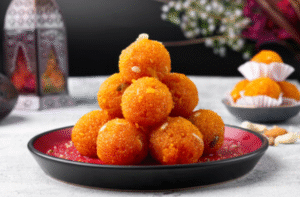Motichoor Laddu, a beloved Indian sweet, is renowned for its delicate texture and rich flavor. Crafted from tiny gram flour pearls (boondi) soaked in aromatic sugar syrup, these laddus are a staple during festivals and special occasions. Here’s a comprehensive guide to making them at home:
Motichoor Laddu, a cherished Indian sweet, boasts a rich history that spans centuries and regions. Its name derives from the Hindi words moti (pearl) and choor (crushed), aptly describing the sweet’s delicate, pearl-like globules.

Ancient Origins
The concept of laddus dates back to the 4th century BCE, where they were initially crafted for medicinal purposes. Susruta, an ancient Indian physician, utilized laddus made from sesame seeds, jaggery, and peanuts as antiseptics for surgical patients. Over time, these nutritious balls evolved into sweet treats, becoming integral to Indian culinary traditions.
Mughal Influence
During the Mughal era (16th–19th centuries), Indian sweets underwent significant refinement. The Mughals introduced intricate techniques and a penchant for luxurious ingredients, leading to the creation of Motichoor Laddu. This variant, characterized by its fine boondi (tiny fried gram flour balls) soaked in saffron and cardamom-infused sugar syrup, became a royal delicacy served during grand celebrations.
Regional Significance
-
Northern India: States like Rajasthan and Uttar Pradesh are often credited with popularizing Motichoor Laddu. Its long shelf life made it a favored travel snack and festive offering.
-
Eastern India: In Odisha, historical texts and temple sculptures depict deities like Lord Ganesha holding laddus, indicating the sweet’s cultural significance.
-
Bishnupur, West Bengal: This region’s unique Motichoor Laddu, made from Piyal seed flour, has earned a Geographical Indication (GI) tag, highlighting its distinctive preparation and historical roots linked to the Malla kings.
Cultural Importance
Motichoor Laddu is more than just a dessert; it’s a symbol of celebration and devotion. Commonly offered during festivals like Diwali and Ganesh Chaturthi, it also features prominently in religious rituals and as prasad (sacred offering) in temples. Its presence in art and literature underscores its deep-rooted significance in Indian culture.
Ingredients
For the Boondi:
-
1 cup besan (gram flour)
-
2 tablespoons fine rava (semolina)
-
¼ teaspoon saffron or orange food color
-
1½ cups water
-
Ghee or oil for deep frying
For the Sugar Syrup:
-
1 cup sugar
-
½ cup water
-
¼ teaspoon cardamom powder
-
½ teaspoon lemon juice
-
1½ teaspoons kewra water or rose water (optional)
-
A pinch of saffron strands or food color
For Garnish:
-
2 tablespoons chopped cashews
-
2 tablespoons chopped pistachios
-
Melon seeds (optional)
👩🍳 Instructions
1. Prepare the Batter:
-
In a mixing bowl, combine besan, rava, and food color.
-
Gradually add water to form a smooth, lump-free batter with a flowing consistency.
2. Fry the Boondi:
-
Heat ghee or oil in a deep frying pan.
-
Using a perforated ladle or boondi jhara, pour the batter to form tiny droplets into the hot oil.
-
Fry until the boondi turns golden but remains soft. Avoid over-frying to maintain softness.
3. Prepare Sugar Syrup:
-
In a saucepan, dissolve sugar in water and bring to a boil.
-
Add cardamom powder, lemon juice, and saffron strands or food color.
-
Boil until the syrup slightly thickens but doesn’t reach a string consistency.
4. Combine Boondi and Syrup:
-
Add the fried boondi to the hot sugar syrup.
-
Mix well to ensure the boondi absorbs the syrup.
-
Let it rest for 10 minutes.
5. Shape the Laddus:
-
Add chopped cashews, pistachios, and melon seeds to the boondi mixture.
-
Once the mixture is warm and the syrup is absorbed, grease your palms with ghee and shape the mixture into round laddus.
